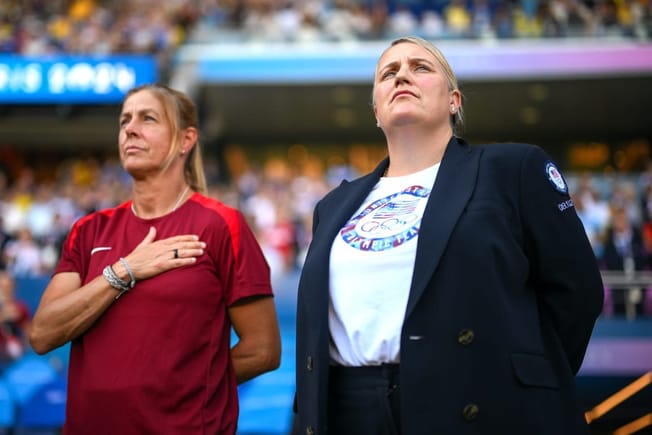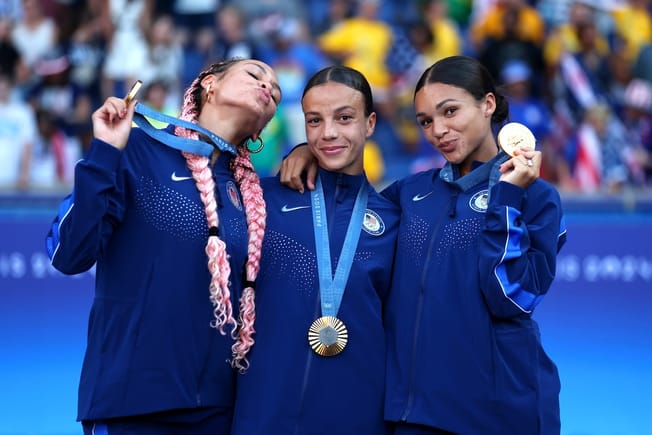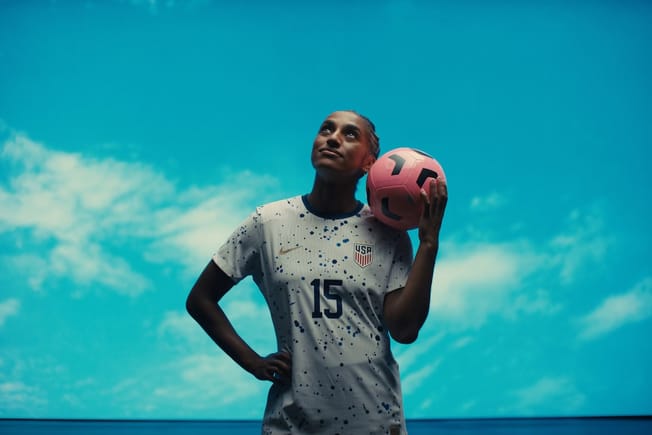“It always feels good to be called a champion.”
That’s Alex Morgan, after the United States beat Canada on Monday to win the Concacaf W Championship. The USWNT won all five of their games during their time in Mexico and successfully qualified for the 2023 World Cup and the 2024 Olympics along the way.
What did we learn about this U.S. team from their performances at the W Championship? Let’s run through five key takeaways.
THE USWNT IS THE BEST TEAM IN CONCACAF
And it’s not particularly close.
From their first group stage game against Haiti to their win in the final against Canada, the United States was the best team at this tournament. The USWNT left Mexico with a 5-0-0 record and a +13 goal differential. The United States smothered teams for large stretches, consistently limiting their opponent’s attacking chances. Even against Canada, the team that beat the United States in the semifinals of last year’s Olympics, the U.S. only gave up low-percentage shots to the tune of 0.53 expected goals.
“We came here with a few objectives: win this tournament, qualify for the World Cup, qualify for the Olympics,” U.S. center back Alana Cook said on Monday night. “And we’ve done all of it.”
"We came here with a few objectives and we've done all of it." 💪
— Attacking Third (@AttackingThird) July 19, 2022
Alana Cook talks with @jennyachiu after winning the @ConcacafW Championship. 🔒 pic.twitter.com/EfVms6AWiU
Between their undefeated record and how they kept Canada (who won four straight games with a +12 goal difference before the final) at bay, it’s clear that there is still a very real gap between the USWNT and the rest of Concacaf. That’s not to say that the rest of the region isn’t improving. But the U.S. is the deepest and most talented team in Concacaf right now, even while missing key players and undergoing a partial changing of the guard.
It’s difficult to imagine that changing any time soon.
QUESTIONS REMAIN ABOUT ANDONOVSKI
Before we get to those questions, though, I want to give Vlatko Andonovski some credit. He provided a platform for players like Naomi Girma, Emily Fox, and Sophia Smith to get tournament experience at the W Championship. That’s a useful thing, especially with two major tournaments coming up in the next two years.
That said, I still have some real questions about some of Andonvoski’s decisions and about his tactical approach.
In an energy-filled game against Canada, the U.S. waited until the 88th minute before making their first substitution. Smith was struggling to track back. Rose Lavelle was visibly exhausted. The USWNT, as a whole, was losing steam. It didn’t end up hurting the United States, but waiting until the dying minutes of the second half to make changes was a big risk. Andonovski hoped that his starters could last basically until the final whistle. Fortunately for him, they did.
The words “hoped” or “hopeful” actually describe Andonovski’s attacking approach pretty well.
I wrote about this before the W Championship started: the U.S. love to cross the ball and we saw plenty of crosses and forced passes in this tournament. Against Haiti, the U.S. heavily relied on crosses to create their chances. Against Mexico, the U.S.’s possession spacing left a sizable gap between the backline/midfield and the attacking line, which prompted long ball after long ball. Then, against Canada, there was a whole lot of this…
There's been a *whole lot* of this direct, hopeful play in the first half from the USWNT pic.twitter.com/X13D22lNta
— Joseph Lowery (@joeclowery) July 19, 2022
Don’t get me wrong, there were some nice attacking moments from the United States over the last couple of weeks.
But my frustration (and really, concern) about Andonovski’s U.S. team is that they’re inconsistent in the attack. And hopeful. It’s not that playing direct passes up field or crosses into the box is bad. But repeatedly crossing into a sea of defenders in the box is inefficient and forcing direct passes minimizes the touches that the U.S.’s star attackers and midfielders get on the ball.
The United States end up hoping that the opposition makes a mistake instead of truly leveraging their attacking firepower into forcing that mistake.
Against teams in Concacaf, the U.S. can more than get by with that approach. But what happens when they play better teams at the World Cup and the Olympics? That’s when things could get dicey.
SO. MUCH. ATTACKING. QUALITY.
Coming into this tournament, it felt to me like the stage was set for Mallory Pugh and Sophia Smith to dominate.
With their speed and skill, those wingers are two of the best attackers in the world right now. Pugh and Smith both made their mark on the tournament, but they didn’t truly dominate. Neither player scored in more than one game: Pugh scored once against Costa Rica, while Smith snagged a brace against Jamaica.
It wasn’t the Pugh and Smith show for the United States. Instead, it was the there’s so much attacking quality and depth in this team where do you even start show.
Alex Morgan led the USWNT with three goals and had a great tournament. With her movement in behind and her ability to hold up play in transition, Morgan will still be a key player for the U.S., even when Catarina Macario works her way back from injury.
⚽️ @alexmorgan13 scored from the spot!
— Concacaf W (@ConcacafW) July 19, 2022
The goal for the title @USWNT! 🇺🇸#CWC pic.twitter.com/23rnMzrLI3
Midge Purce was active and effective on the right wing for the U.S. in her time on the field. Trinity Rodman showed some flashes across the entire frontline. Ashley Sanchez looks ready for a bigger role as a creative, attack-minded midfielder.
If the USWNT refine their attacking play and learn how to take full advantage of their quality up front, they’ll be an absolute nightmare to play against over the next two years. Even without any of that refining, they certainly gave the rest of Concacaf fits at the W Championship.
THE NO. 6 SPOT IS UP FOR GRABS
Without Julie Ertz, Andonovski used Andi Sullivan, Lindsey Horan, and Kristie Mewis at the base of midfield over the last few weeks. Sullivan played the majority of the minutes at the No. 6 spot, starting four of the five games for the United States down in Mexico.
However, Sullivan didn’t come close to locking down that central defensive midfield spot. Her passing was spotty and she turned the ball over in some bad spots during her minutes in qualifying.
I don't think Andi Sullivan locked down the No. 6 spot for the USWNT over the last few weeks. Her lack of ability on the ball is an issue for the United States. pic.twitter.com/FDDZgPMv0g
— Joseph Lowery (@joeclowery) July 19, 2022
With the other quality possession players that they have, the U.S. can get away with using a No. 6 who is limited on the ball. But for that No. 6 to provide value, they have to be extremely effective defensively and in transition. Sullivan made some big defensive plays in Mexico, but I’m just not sure that she has the range and ability to really make that defensive midfield spot her own.
We’ll see if Andonovski decides to look for other options at the six when the U.S. take on Nigeria in a pair of friendlies in September.
GIRMA MAKES HER CASE
Naomi Girma had just one appearance with the U.S. and 16 professional games under her belt before the USWNT’s pre-tournament friendlies against Colombia.
You couldn’t tell, could you?
Girma didn’t start either of the U.S.’s knockout games against Costa Rica or Canada, so she wasn’t tested all that much, but she looked exactly how you would want a center back to look against inferior opposition: comfortable, confident, and technical. You can see some of all three of those attributes with this precise pass out to Smith on the right wing.
🇺🇸 @sophsssmith scores the first of the night after a long pass by @naomi_girma!@USWNT #CWC pic.twitter.com/jZuDlQbHdy
— Concacaf W (@ConcacafW) July 8, 2022
Girma showed off a strong passing range and some mobility in the back at the W Championship – those two things make her an intriguing option to get more minutes in the near future. As Becky Sauerbrunn continues to age, she is become less and less capable of defending in space. At just 22, Girma doesn’t have Sauerbrunn’s experience (to be fair, almost no one on planet earth does), but she looks ready to take on more responsibility with the USWNT.
I expect her to fight hard for minutes at one of the U.S.’s center back spots for the foreseeable future.







Comments